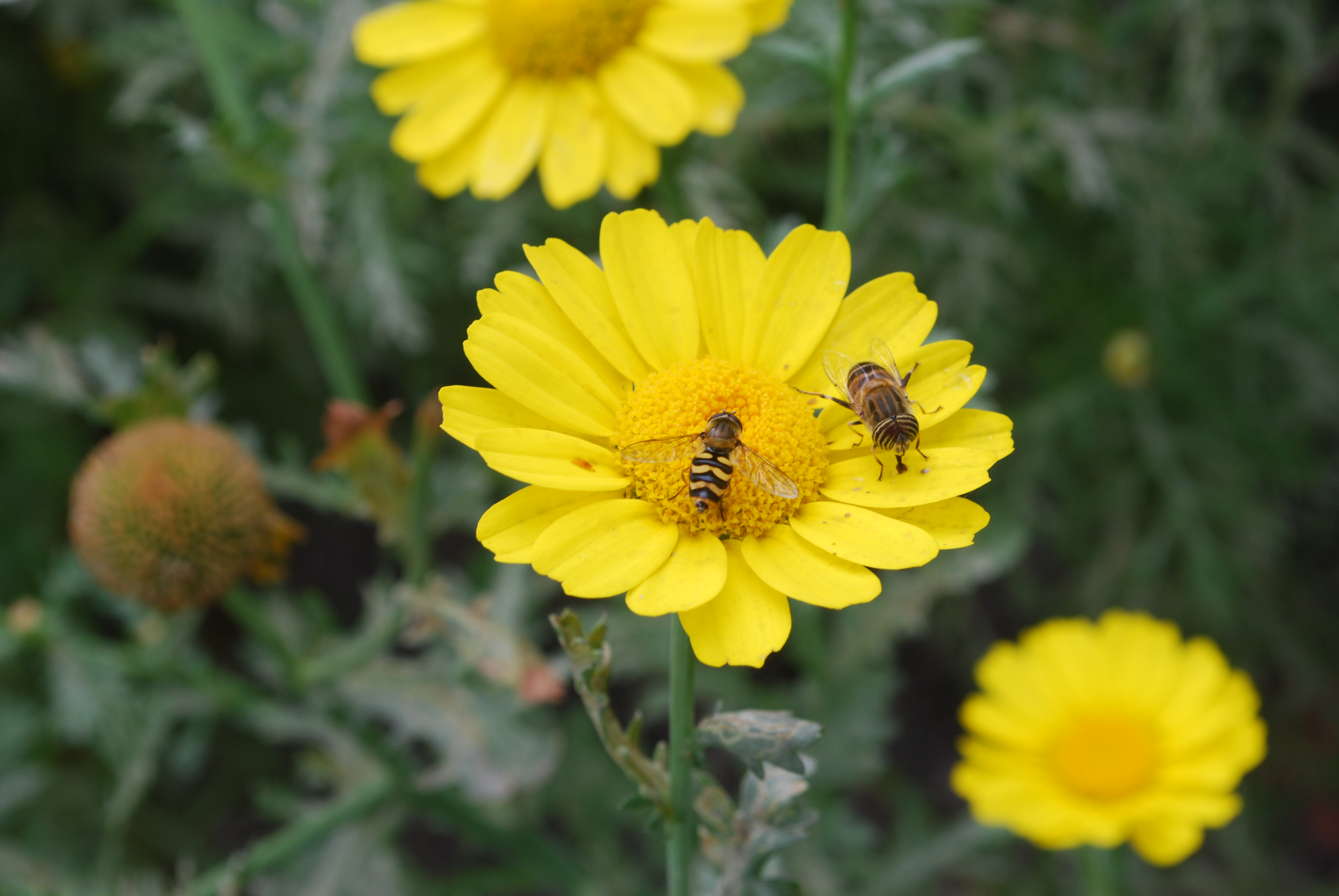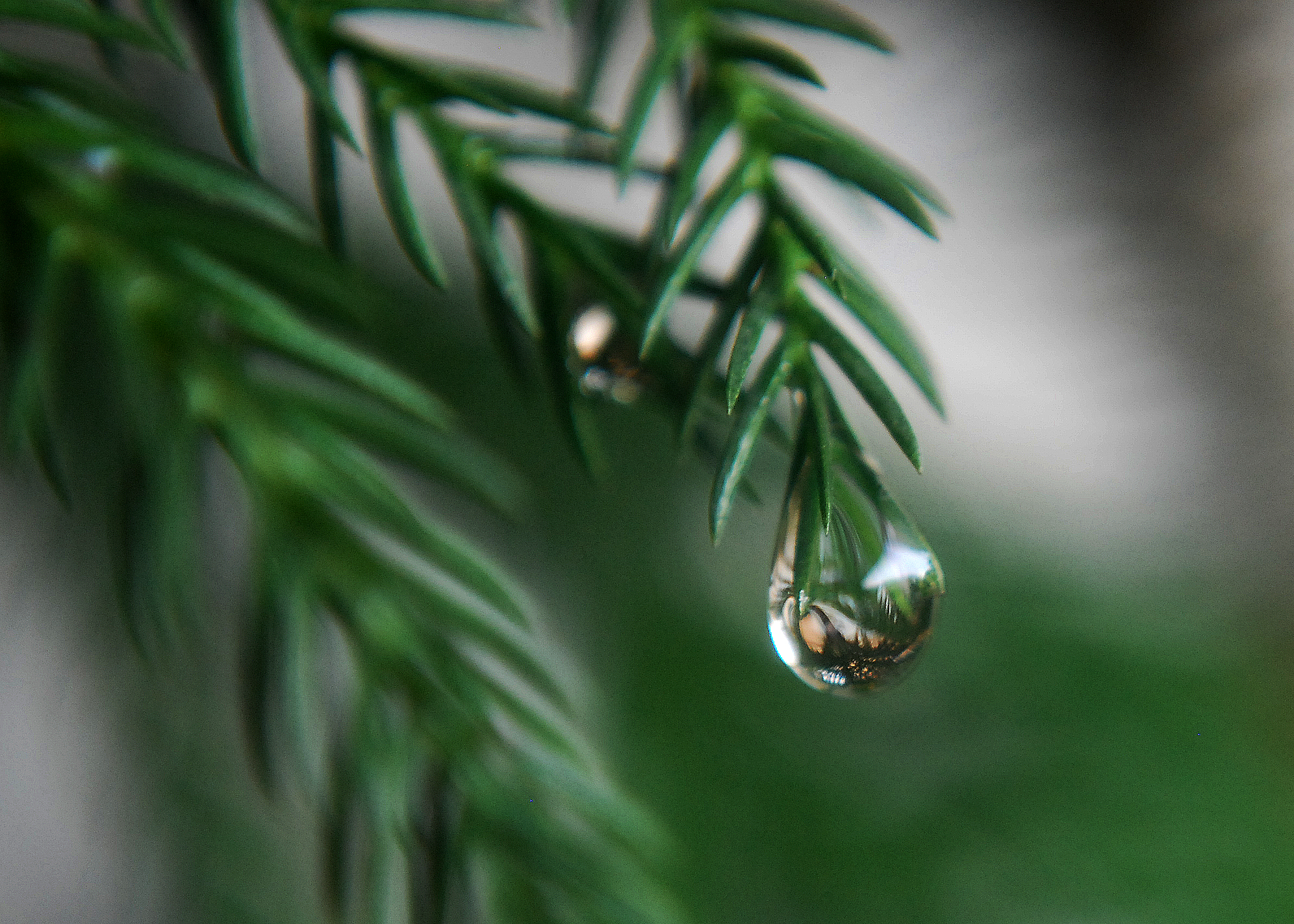Indus Valley Civilization (c. 2500-1500 BC)
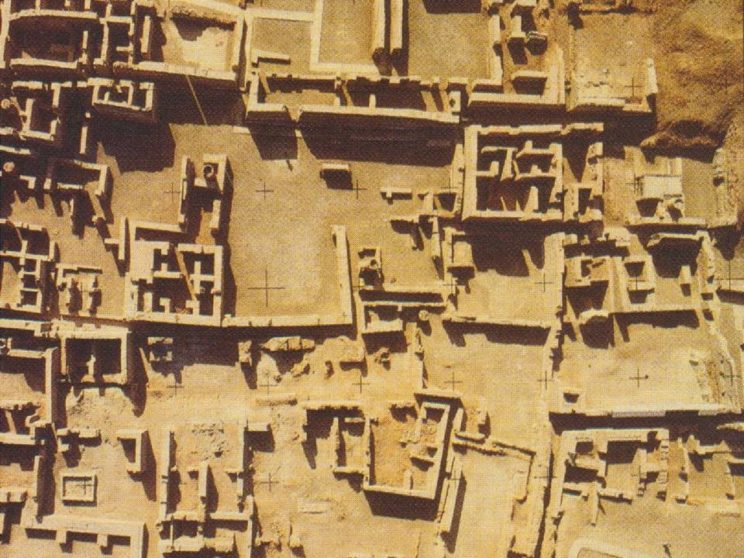
- Nearly 5000 years ago, a highly developed civilization existed known as INDUS VALLEY CIVILIZATION, which was known as the ancient phase.
- It was identified in 1922 AD by Mr. R.D. Banerjee who during excavation work at Buddhist stupa at Mohenjodaro, discovered some unknown types of bricks.
- Also, Mr. R.B. Dayaram Sahani discovered the remains at Harrapa in Montgomery district of Punjab.
- Finally in 1924 AD it was announced by Sir John Marshel that there existed an urban civilization in the valley of river indus.
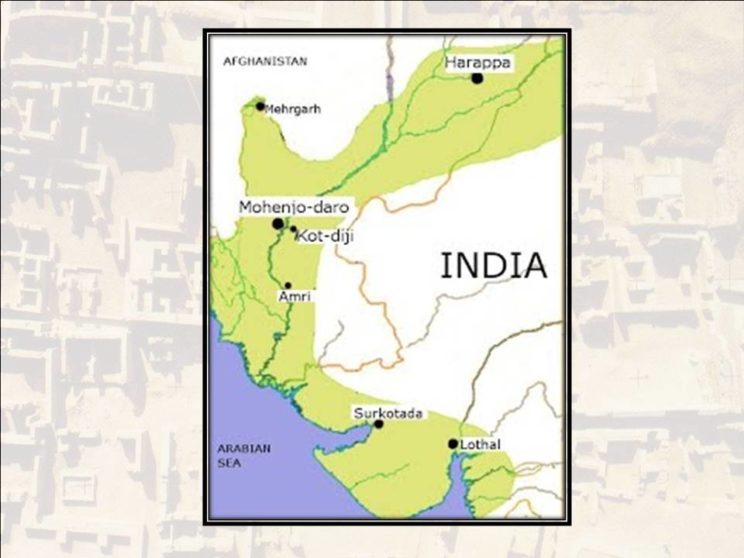

- This civilization existed along with the ancient culture of Mesopotamia; also called Indian Sumerian Civilization as there were lot many similarities in two.
- The boundaries extended from North west frontier province in Pakistan to the foot hills of Himalayas down to Gujarat; also into Ghaggar valley and Ganges; covering Pakistan and some areas of Baluchistan.
Important Cities:
- Ropar- Punjab
- Lothal- Gujarat
- Kalibhangan- Rajasthan
- Banwali- Haryana
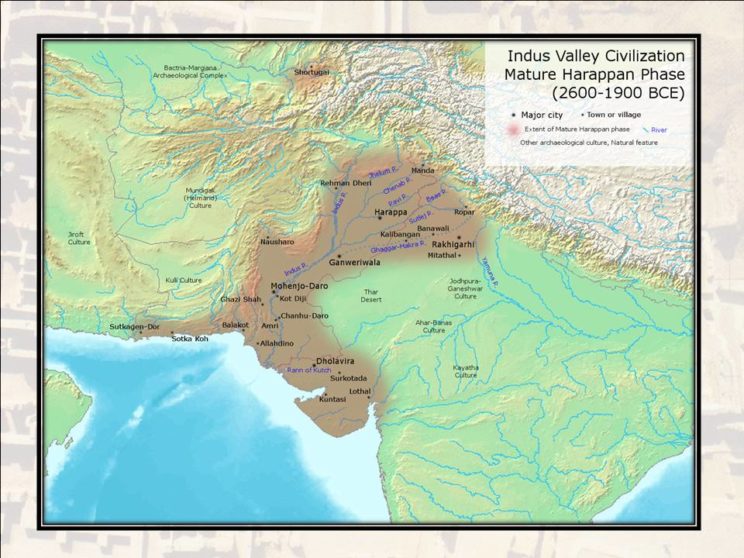
Two Principal Cities:
- HARAPPA
- MOHENJODARO
HARAPPA: situated at the banks of river Ravi at Montgomery district of Punjab; 100 miles from Lahore.
MOHENJODARO: situated in Lalkvana district of Sindh; 300 miles north of Karachi in Pakistan.
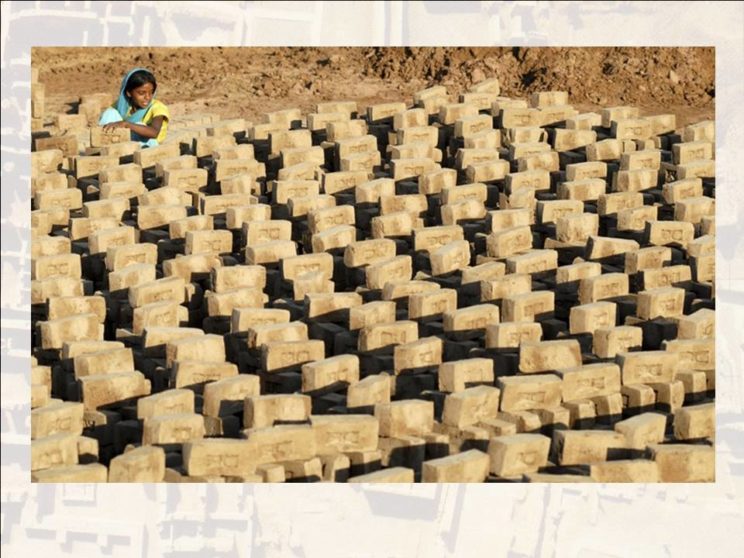
Town Planning:
- The common building material at Harappa sites were baked bricks.
- Baked Bricks of standard size and qualities were used as the common building material at Harappa sites; which were discovered from the kilns situated at the sites.
QUALITIES
Ø Sun dried mud bricks and burnt bricks used for raising sculptures.
Ø Also to fill floor areas and courtyard inside the houses.
Ø Size is larger than those used at present.
Ø Used in English bond style; which provides extra stability to the walls.
Ø Mud matter used as binding agent and to cover the inner walls of building.
Ø Wedge shaped bricks to maintain roundity; occasionally ‘L’ shaped bricks were used in the corners of the walls.
Drainage System
- Brick line channels were there ; which runs under the walkways and connected to larger sewers.
- Larger sewers were covered with carbelled brick areas; where main holes are located at regular intervals for inspection and proper cleaning.
- Smaller sewers were covered with brick slabs.
- These drains carried rain water and other waste matter; passed through all the streets and were covered with loose brick slabs at various intervals so that they could be removed whenever necessary.
- They opened into larger drains which finally exit into the river.
- One major disadvantage was that it led to contamination of water when the drains were placed in the wells.
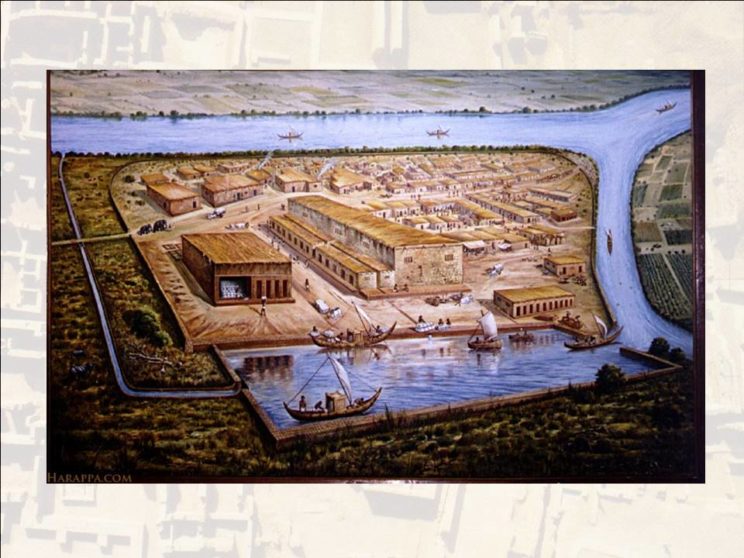
EFFECTIVE AND EFFICIENT CIVIC ORGANISATION
- This ancient civilization has been indicated as the most civic organisation.
- Buildings were not allowed to encroach on the public highway roads, nor allowed to be constructed in hap hazard manner.
- Street lightening was indicated by regular lamp posts traces found.
- High civic sense indicated by traces of proper pitholes at regular intervals for disposal of garbage.
- Many trees and plants were grown within the enclosure of the city.
ARCHITECTURE
Three types of buildings were constructed:
- Dwelling houses
- Public halls
- Public baths
DWELLING HOUSES
- They were many in number.
- Smaller houses had no more than two rooms.
- Larger houses were palace like. Every house had its own bathrooms, wells, kitchen, courtyard and drains.
- The house roofs were made of brick tiles laid over timber rafters.
- There was a central courtyard open to the sky around which the rooms were constructed, which lead to proper light and illumination.
- The only form of interior decoration was by narrow pointed niches.
Public Halls
- Close-up view of the pillared hall, which may have been a hall of assembly with paved walkways and places for people to sit in ordered rows along each aisle between massive brick pillars.
- The pillared hall was approximately 27.5 meters square (90 feet square) with twenty square brick pillars arranged in four rows, only two of which are still preserved. Strips of paved floors sloped from south to north and each strip of flooring had row of bricks set on edge along both sides. The cross wall in the foreground was built later and divided the hall into smaller rooms.
Public Baths
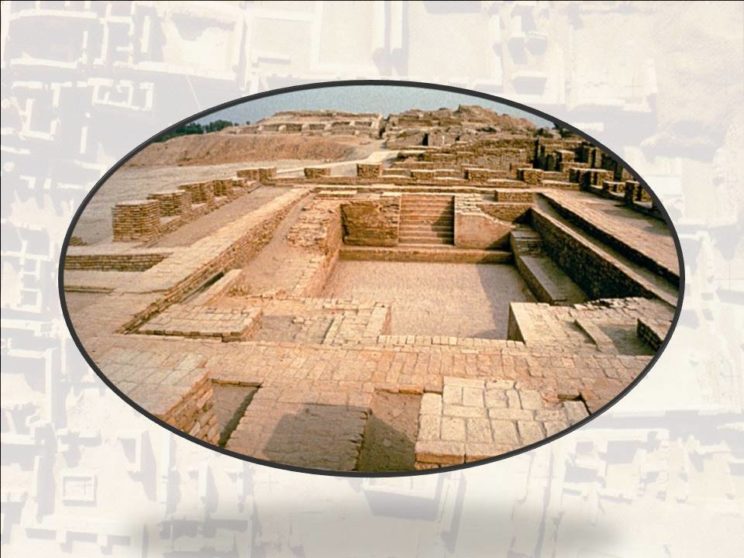
- To the west of the stupa mount stood the very interesting and amazing structure known as The Great Indian bath.
- It is constructed entirely of burnt bricks measuring 39’*3” in length, 33’*2” in width and 8’ deep.
- The entire complex is connected to an elaborate water supply of fresh water from a nearby well constructed with burnt bricks.
- The great bath seems to be an idiom of swimming resort.
SCULPTURES
INTRODUCTION
- Sculpture of Indus Valley Civilization is considered to be a golden chapter as the beginning of Indian art and sculpture in 3000 B.C.
- According to the forms of art excavated from this valley, it can be easily indicated that the people of this civilization were great lovers of the fine arts especially of dancing, painting and creating sculptures.
- The forms of art include various sculptures, seals, pottery, gold, jewellery, terracotta figures, and other interesting works of art.
# Bust of Priest (Mohenjodaro)

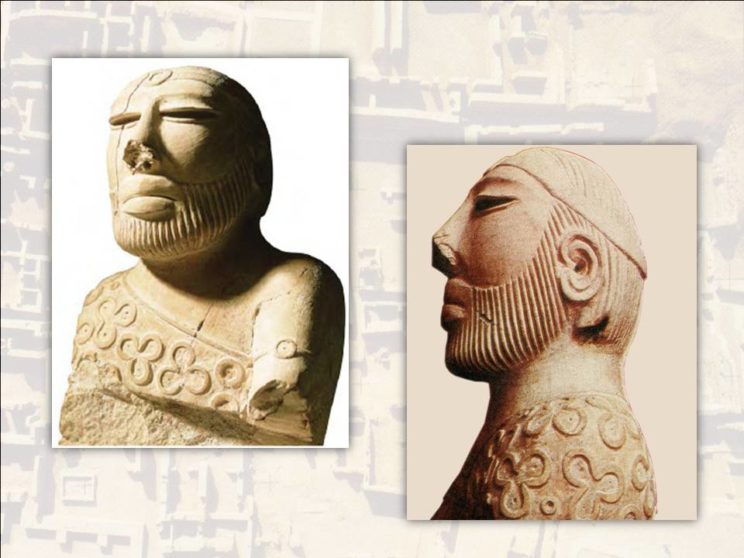
C.3000 – 1500 BC
Material – Limestone (17cms)
National Museum, NewDelhi
- It represents a bust of bearded men; which depicts saintly appearance, drapped in shawl like garment around the left shoulder and right arm.
- The drapery is decorated with trifoil pattern; which represents fabric in a realistic manner.
- This pattern could be seen in the art of early egypt and Harappan works.
- The tip of the nose is chipped off with unusually thickened lips.
- The flat circular ornament headband depicted him to be a man of higher rank.
-
Dancing Girl
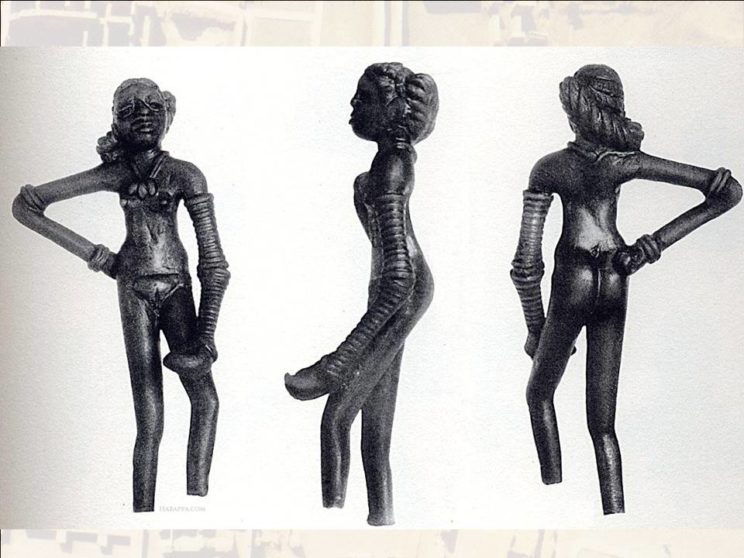
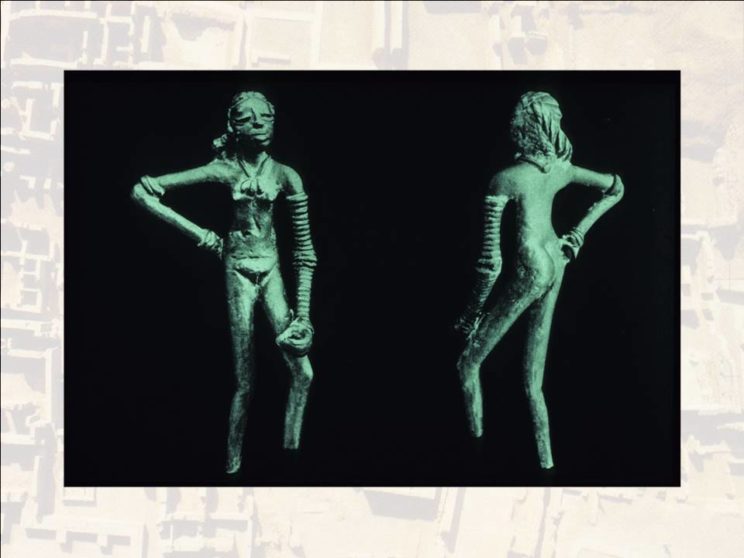
- c.2300-1750B.C
- From Mohenjo-daro
- Material- Bronze
- National Museum, New Delhi
- Most exclusive bronze sculpture found from Mohenjo-Daro.
- A girl standing in a dancing posture with her right hand placed on her hip and both her legs apart.
- She holds an unidentified object in her left hand and wearing 24 bangles in hand.
- The hair is tied in the form of bun which rests on the right shoulder.
- The negroid features depicts her to be dasas, as described in rig vedas.
- Her nose is flattened with unusually thickened lips and elongated arms and legs.
- The body is disproportionate with treatments of the back suggesting the alertness of the dancer.
- There is certain amount of sophistication in the movements of the body.
- This figure is rightly said as Dancing Woman.
-
Nude Male Torso
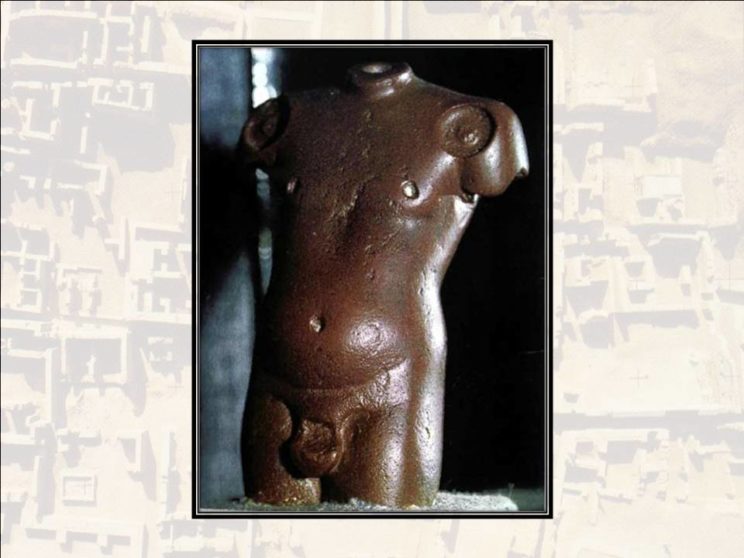
- From Harappa
- C.2700-1750 B.C.
- Material- Red Sandstone
- National Museum, NewDelhi
- One of the most interesting and sophisticated harappan image, it represents a well known piece of sculpture, which exhibits a great monumentality.
- Head and hands are missing with legs broken from the thigh.
- It seems as if there is a socket hole into which the hands and legs are fitted into.
- The prominent belly in the image is also an Indian element depicting physical and spiritual well being.
- The exaggerated depth of naval suggests softness of the flesh.
Dancing male Torso
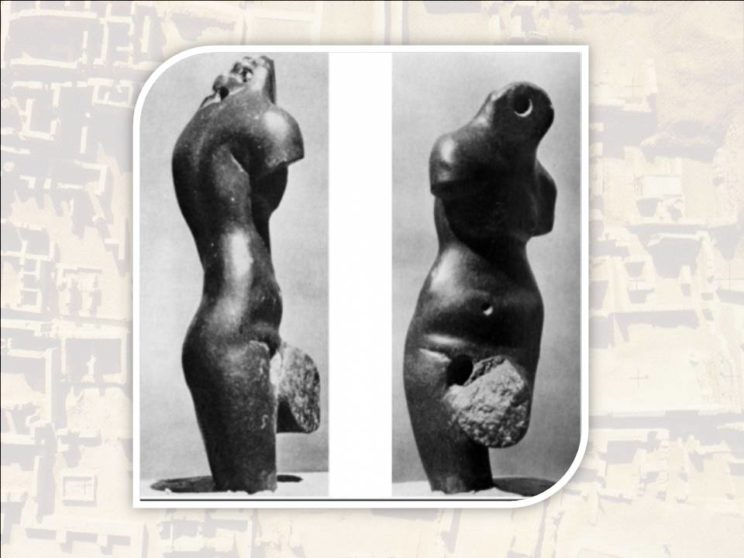
- From Harappa
- C.2700-1750 B.C.
- Material- Limestone
- National Museum, NewDelhi
- This is a male figure from harappan origin.
- The torso was 4 armed and 3 headed which were now missing fitted in the socket holes at the right place in the body.
- The left leg was drawn up high in front and upper body was tilted towards left.
- The body is subtly modelled with soft contours.
- The nudity of this figure remains a mystery.
Mother Goddess
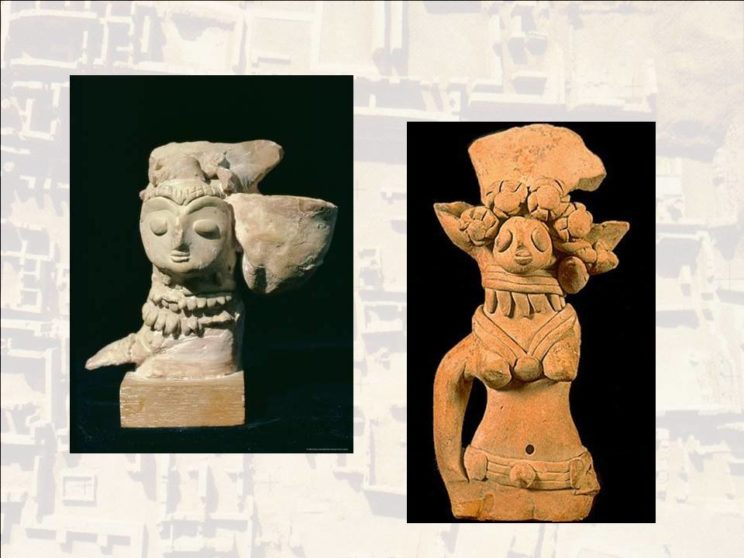
- 2300-750 BC
- From Mohenjodaro
- Material- Terracotta
- National museum, New Delhi
- It is a clear representation of Mother Goddess.
- The first noticeable ornament was the large headgear and elaborated jewellery in the neck area.
- It provides the get up of Mother Goddess , depicting the existence of mother cult at the harappan site.
- This figurine is very primitive in appearance; made by pinching and appliqué technique.
SEALS
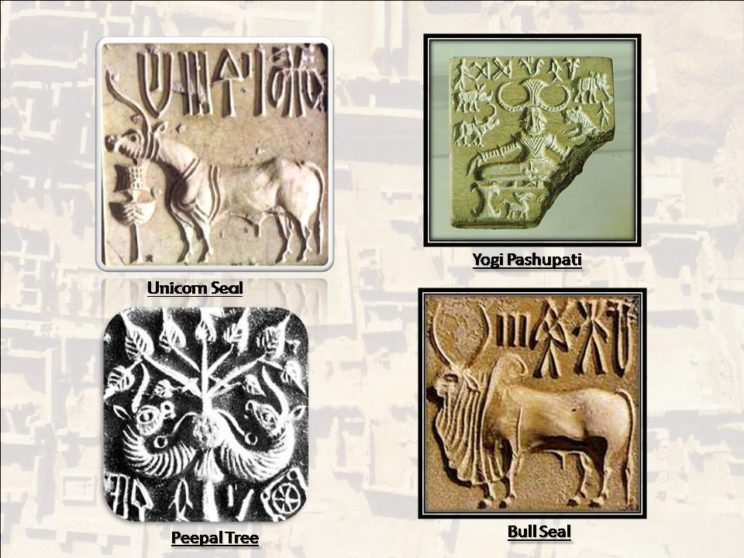
- Most important find of Indus valley civilisation.
- More than 2000 have been discovered.
- Majority of these seals have been derived from Harappan, Mohenjodaro and Lothal sites.
- These are square or rectangular shaped, about 2-4 cm in size and are ported with soda ash followed by firing.
- They have incorporated within them intaglio (engraved) designs, which depicts animals, plants, geometric forms, humans or mythical animals.
- Grotesque or composite animals are suggestive of religious symbols.
UNICORN SEAL
- Ca. 2100 – 1700 BC
- Material- Steatite
- From- Mohenjodaro
- Unicorn is the most common motive of the seal; it has perforated boss on the back.
- It represents a mythical animal.
- On the top of the seal, there is a long inscription of symbols.
- The representation of animal is in the form of a 2 horn bull.
- There is an indistinct double ribbed pad across the shoulder.
- It is subtly modelled and visible anatomically.
Bull Seal
- 3000-1500 BC
- Steatite
- Mature Harappa Culture
- Depicts a strong humped Brahmini bull.
- The striking feature is the fleshy limbs along with white curling horns.
- The body is muscular and massive, still appearing weightless.
- It represents combination of various profiles as the head and body is in profile and eyes and horns are clearly frontal.
- The detailed representation of the animal anatomy shows the keen interest and eye of the carver to keep subjects alive by defining everything that is important for the nature of animal.
Seal showing a Yogi Pashupati
- Mohenjodaro
- C.2100-1750 B.C.
- Steatite
- Height- 3 inches.
- The figure depicts a male who sits in yogic posture; with arms extending away from the body and thumbs rest on his knees while his fingers point downwards.
- This posture is suggestive of a specific asana or mudra or may be the Padma Asans.
- It shows Rhinoceros and water buffalo on one side and elephant and tiger on other side.
- The head rest showed triparted form crowned by buffalo horns; which resembles the trident of Lord Shiva.
- The seal was originally square in shape, but has now been destroyed from corner above.
Unicorn &
Peepal Tree
- Mohenjodaro
- C.3000-1500 B.C.
- Steatite
- 13 Inches.
- It depicts a conventionalised form of a Peepal tree which also occurs on the pottery as a motif or design as early as in Pre Harappan culture.
- Peepal tree was one of the few distinct species on Harappan seals.
- The head and neck of these two animals are projecting from the piece, with an ornamental design below the growing trees with cobras about to strive.
- It depicts the serpents (nagas) gathered to pay homage to the Buddha.
POTTERY
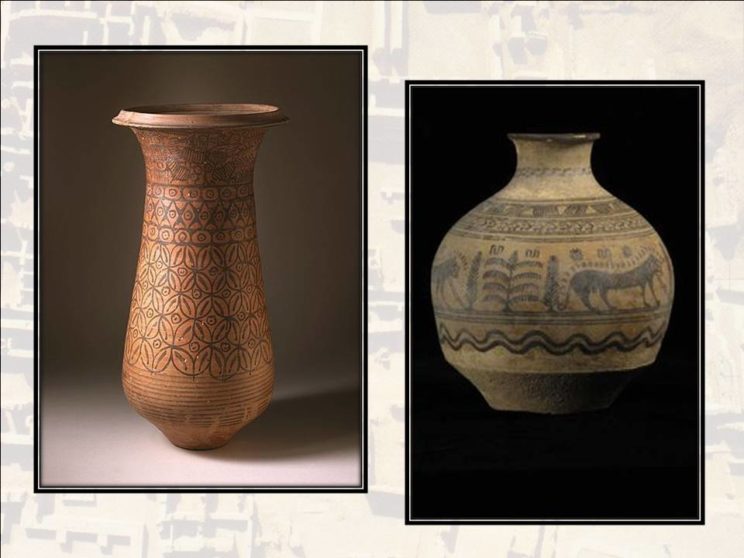
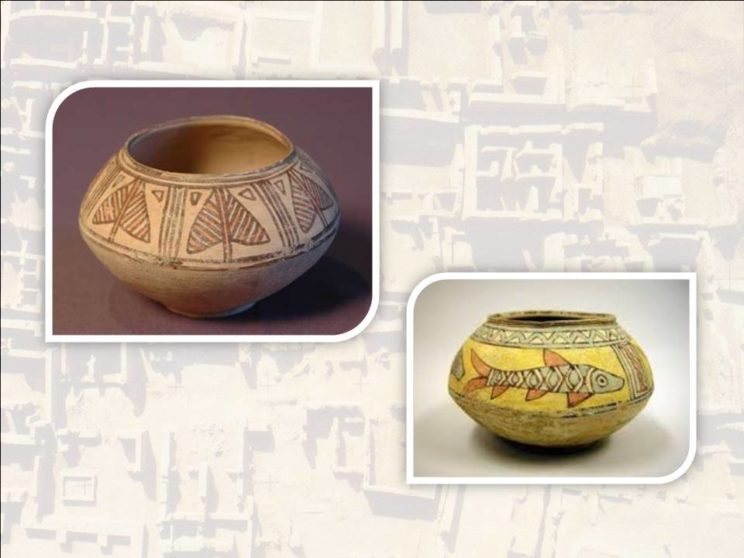
- The excavations in the Indus Valley yielded a variety of pottery which is plain and decorated and contain a variety of unglazed and glazed pottery.
- Plain undecorated pottery is more common at Mohenjo-Daro than painted ware. But the well-known painted red and black wares were adorned with black colored designs on red background.
TOYS
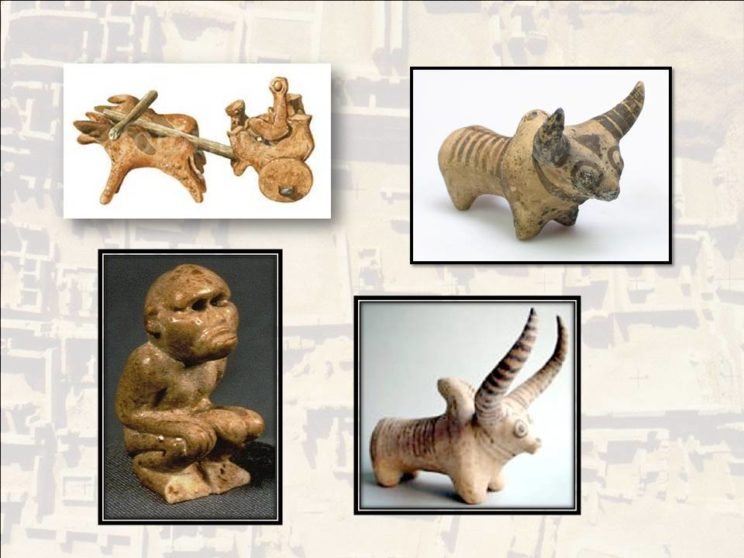
TERRACOTTA ANIMAL FIGURINES
- Here variety of animals have been seen such as bull, monkeys, lambs, buffalos, goats, tigers and rhinoceros etc.
- The short horned bull species exist most frequently; sometimes with head lower as if ready for a charge and sometimes shown with garlands around the neck.
- Occasionally, a bell has been seen suspended from the neck.
- Other species frequently presented are monkeys and lambs.
Monkey Figurenes/ Toy Glazed Ceramic
- C. 3000-1500 B.C.
- From Harappa
- Material- Glazed Ceramic
- Out of all the animals, monkeys are most artistically rendered.
- Though it has never appeared on the seals, but it has been modelled in steatite a large number of times.
- This figurine is made in two different ways:
Firstly, those with the skin treated in naturalistic manner; secondly, with an incised line in the skin sometimes also with hands resting on knees.
JEWELLERY
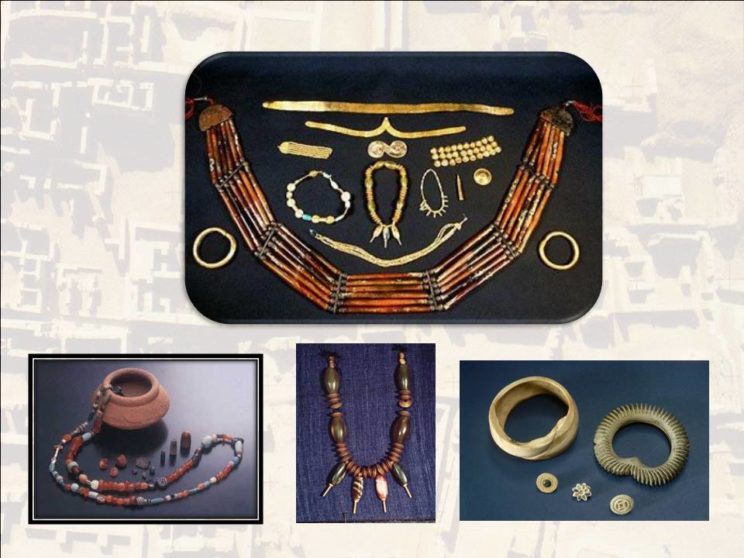
- Very little work has been done on the ornament styles by people of Indus valley civilization.
- It was considered that the ornament styles depicted person’s age, social status, ethnic identity and even religious affiliation.
- Ornaments are made of specific types of raw materials and are of standardized sizes, shapes and colors.
- Valuable stones and metals are fashioned into ornaments that depict various ritual or symbolic motiffs.
- Bead -any object that is perforated along its major axis, generally worn on a cord or wire, sewn onto clothing or used as an ornament.
- Pendant -any object that is perforated or scored at one end and is hung or attached to a cord or wire, sewn onto clothing or used as an ornament.
- Bangle -any circlet (closed or open) made of a continuous homogeneous material that can be worn on the arm or ankle.
- Bracelet -any circlet made of components such as beads, chain or cord, etc. that can be worn on the arm or ankle.
CONCLUSION
To conclude we can say that the Indus Valley civilization resembles a great deal with those of Egypt, Mesopotamia and China.
The developed urban life, the use of the potters wheel, kiln-burnt bricks, copper and bronze vessels and pictorial writings are some of the common distinct characteristics of all these civilizations. Indus Valley civilization thus has contributed many valuable imprints to the human civilization.
